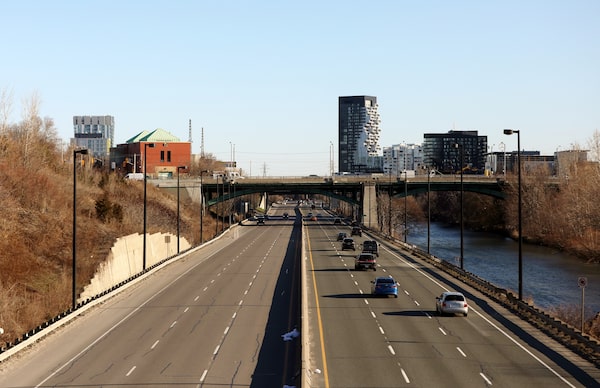
Toronto's normally jammed Don Valley Parkway is seen during the evening rush on Thursday, April 2, 2020. Dubbed the Don Valley Parking Lot, the main highway has decidedly little traffic amid closures and other isolation measures aimed at curbing the COVID-19 pandemic. THE CANADIAN PRESS/Colin PerkelColin Perkel/The Canadian Press
It’s a road map, not a calendar, Ontario Premier Doug Ford and his ministers said about 30 times in describing their very vague framework to open some things, though it is not clear what, in progressive stages, some day in the future.
Truthfully, it wasn’t a road map either, lacking as it did any markings of places on the route.
Still, it was a thing – a “framework,” it is officially called – that pulled together cautious public-health principles required to move forward toward reopening.
In that, it contrasted with Quebec Premier François Legault’s plan to reopen elementary schools, which is more calendar than road map.
Mr. Legault didn’t really say how he’s going to make that happen safely, without triggering a resurgence in the COVID-19 epidemic in his province. He talked about the reasons to do it.
He gave five reasons, but they can be roughly summed up as (a) because life must go on, and (b) because we can. The details he provided were more convincing on the first point than the last.
This was a tale of two provinces. Mr. Legault wanted to get on with it. Mr. Ford was straining to be careful.
We won’t know for months which will turn out better. But it would be nice if the premiers had something they could call a “plan.”
Mr. Legault’s was a decision. Those children are going to school. Elementary schools, not high schools and colleges, but not just in the far-flung regions where cases of COVID-19 are few. On May 19, schools in Montreal, Canada’s coronavirus centre, will open, too.
Parents probably were not particularly reassured by Mr. Legault’s argument that schools can open now because the situation in hospitals is under control, and there are empty beds in case, you know, a lot of people get sick.
What was more unsettling was the shrug when asked if the province would be testing in schools. Mr. Legault said Quebec does more testing than other provinces – which is true, but it is also true that the province’s planned ramp-up of testing hasn’t materialized. Horacio Arruda, Quebec’s Chief Medical Officer, suggested there won’t be random testing at schools, but testing if an outbreak is discovered.
Perhaps the risk is low for children. Mr. Legault announced Monday that 75 of 84 of the COVID-19 deaths recorded in the previous 24 hours were in seniors’ homes. But infected children can pass it on to each other, teachers, staff, parents and grandparents. There wasn’t much detail about a plan to monitor spread.
Surely the first thing you want in any plan is a measure to avert disaster. You know, something beyond having lots of free hospital beds.
That’s where Ontario was strangely better. Mr. Ford said the province’s framework was about “how,” not when. In other words, what it takes to reopen.
The “how” was pretty minimalist, too, but it included some sensible conditions. One is that reopening will wait until the province’s public-health system is capable of contact tracing nearly all cases within 24 hours – that is, getting in touch with anyone newly diagnosed with COVID-19, to ask where they have been and who they have met, so they can test those contacts, too. That can help alert the authorities if reopening is prompting a new wave of the epidemic.
The Ontario “framework” has lots of other conditions that err on the side of caution. There will be no opening until there is a steady two- to four-week decline in the number of cases. Health Minister Christine Elliott said an increase in testing – the province is a laggard – will have to be accomplished, too.
Certainly part of Ontario’s approach is right: the “how” is the most important thing, whether the reopening comes May 11th or Marchember 86th.
Unfortunately, after reading Ontario’s framework, you won’t know which is more likely.
It includes three stages, in which, for example business will be opened, with cautious monitoring periods of four to six weeks between each. But don’t ask which businesses will open when: Stage 1 is some, Stage 2 is more and Stage 3 is all. There isn’t much more than that.
What we have is mostly each premier’s inclination: to go fast with a calendar or more carefully with a road map. The “how” should be the key to timing, but that would require a plan.
Know what is happening in the halls of power with the day’s top political headlines and commentary as selected by Globe editors (subscribers only). Sign up today.
 Campbell Clark
Campbell Clark